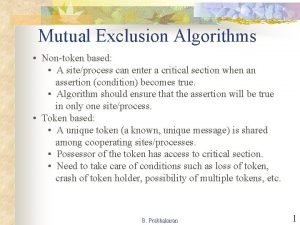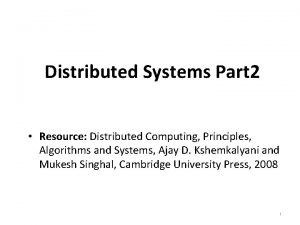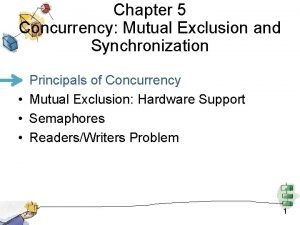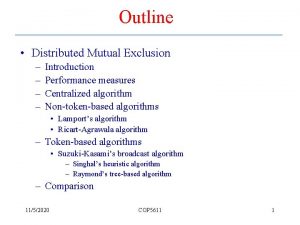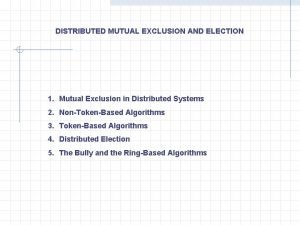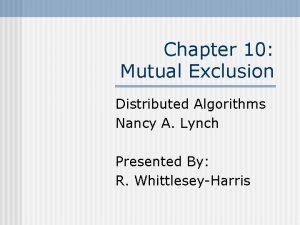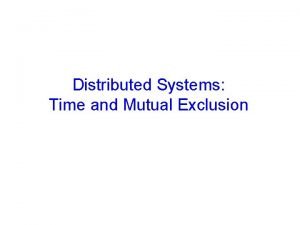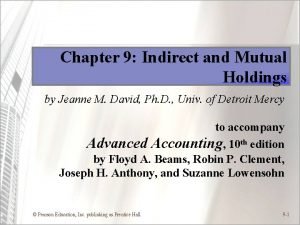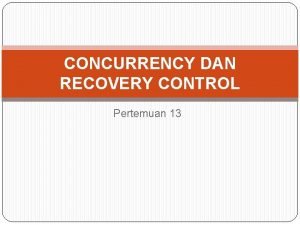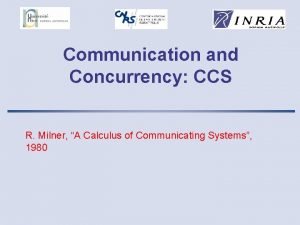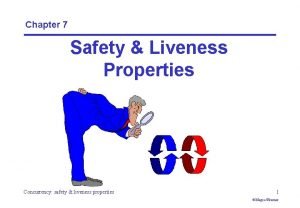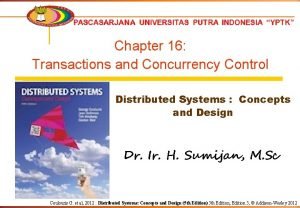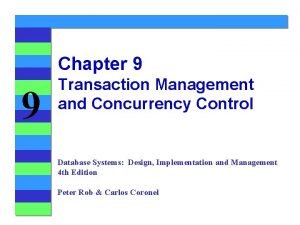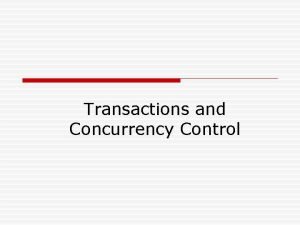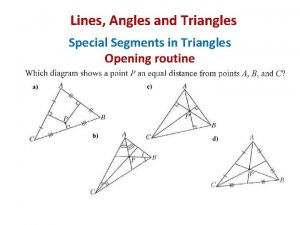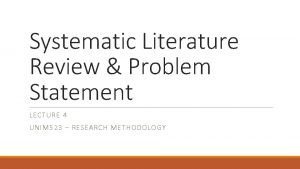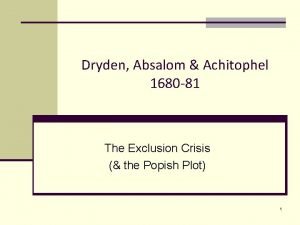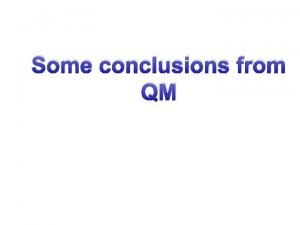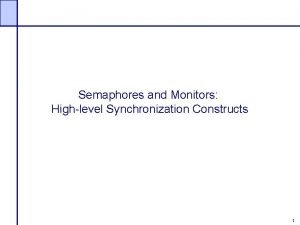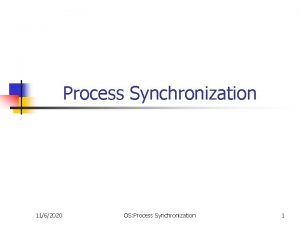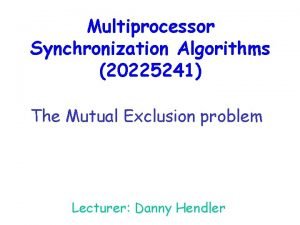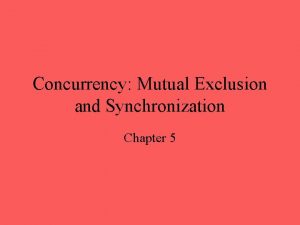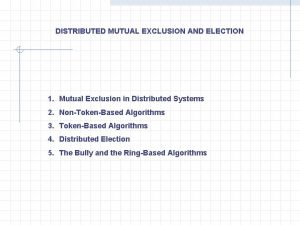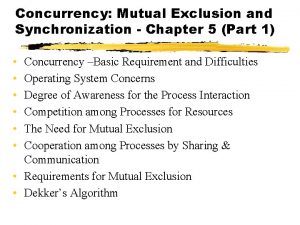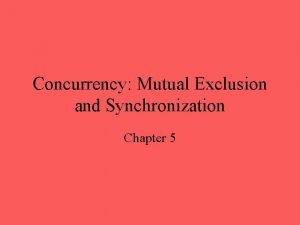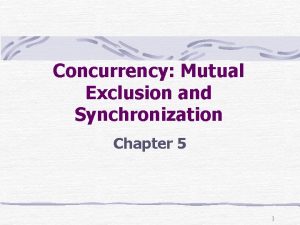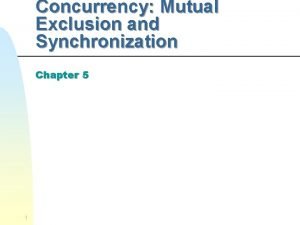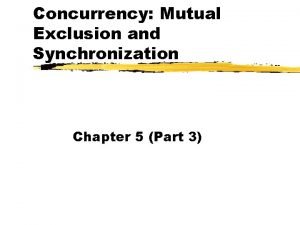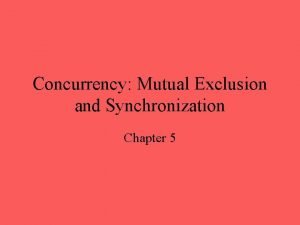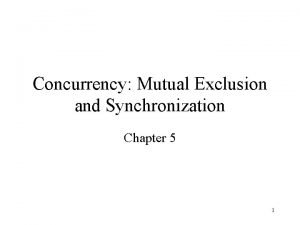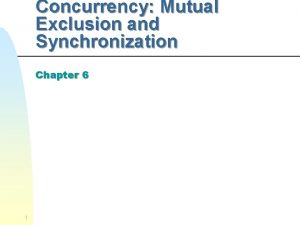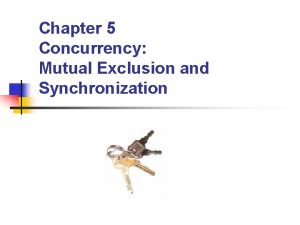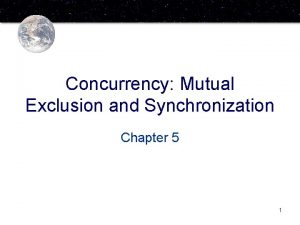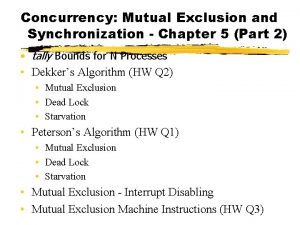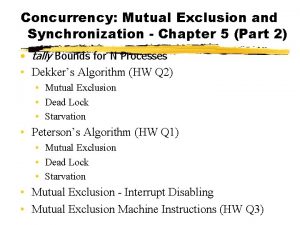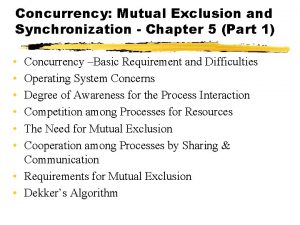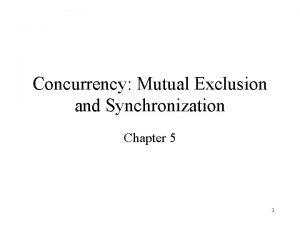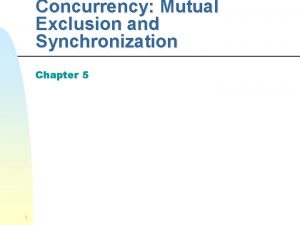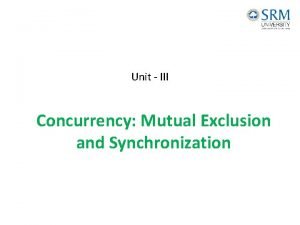Chapter 5 Concurrency Mutual Exclusion and Synchronization Principals










































- Slides: 42

Chapter 5 Concurrency: Mutual Exclusion and Synchronization • • Principals of Concurrency Mutual Exclusion: Hardware Support Semaphores Readers/Writers Problem 1

Multiple Processes • Central to the design of modern Operating Systems is managing multiple processes – Multiprogramming – Multiprocessing – Distributed Processing • Big Issue is Concurrency – Managing the interaction of all of these processes 2

Interleaving and Overlapping Processes • Earlier (Ch 2) we saw that processes may be interleaved on uniprocessors 3

Interleaving and Overlapping Processes • And not only interleaved but overlapped on multiprocessors • Both interleaving and overlapping present the same problems in concurrent processing 4

One Difficulty of Concurrency • Sharing of global resources can be problematic 5

A Simple Example Suppose echo is a shared procedure and P 1 echoes ‘x’ and P 2 echoes ‘y’ void echo() { // send a keyboard-input character to display chin = getchar(); What would happen if P 1 is interrupted here by P 2? chout = chin; putchar(chout); } What would happen if only one process is permitted at a time to be in the procedure? 6

A Simple Example: On a Multiprocessor Process P 1. chin = getchar(); . chout = chin; putchar(chout); . . Process P 2. . chin = getchar(); chout = chin; . putchar(chout); . 7

Enforce Single Access • If we enforce a rule that only one process may enter the function at a time then: – P 1 & P 2 run on separate processors – P 1 enters echo first, • P 2 tries to enter but is blocked – P 1 completes execution • P 2 resumes and executes echo Solution: Control access to shared resource 8

Competition among Processes for Resources Three main control problems: • Need for Mutual Exclusion – Only one program at a time be allowed in its critical section. – Critical resource: nonsharable resource, e. g. , printer – Critical section: portion of the program that uses a critical resource • Deadlock • Starvation 9

Requirements for Mutual Exclusion • Only one process at a time is allowed in the critical section for a resource • A process that halts in its noncritical section must do so without interfering with other processes • No deadlock or starvation 10

Requirements for Mutual Exclusion • A process must not be delayed access to a critical section when there is no other process using it • No assumptions are made about relative process speeds or number of processes • A process remains inside its critical section for a finite time only 11

Roadmap • • Principals of Concurrency Mutual Exclusion: Hardware Support Semaphores Readers/Writers Problem 12

Disabling Interrupts • Uniprocessors only allow interleaving • Interrupt Disabling – A process runs until it invokes an operating system service or until it is interrupted – Disabling interrupts guarantees mutual exclusion because the critical section cannot be interrupted 13

Pseudo-Code while (true) { /* /* disable interrupts */; critical section */; enable interrupts */; remainder */; } – Reduced interleaving – Will not work in multiprocessor architecture 14

Special Machine Instructions • Use of atomic action: instruction is treated as a single step that cannot be interrupted – Compare&Swap Instruction int compare_and_swap (int *word, int testval, int newval) { /* checks a memory location (*word) against a test value (testval) */ int oldval; oldval = *word; if (oldval == testval) *word = newval; return oldval; } 15

Mutual Exclusion (fig 5. 2) • The only process that may enter its critical section is one that finds bolt equal to 0 • All other processes go into a busy waiting mode 16

Hardware Mutual Exclusion: Advantages • Applicable to any number of processes on either a single processor or multiple processors sharing main memory • It is simple and therefore easy to verify • It can be used to support multiple critical sections 17

Hardware Mutual Exclusion: Disadvantages • Busy-waiting consumes processor time • Starvation is possible when a process leaves a critical section and more than one process is waiting – Some process could indefinitely be denied access because selection of a waiting process is arbitrary • Deadlock is possible – Example: P 1 enters its critical section and is then preempted by higher priority P 2 which will go into a busy waiting loop 18

Roadmap • • Principals of Concurrency Mutual Exclusion: Hardware Support Semaphores Readers/Writers Problem 19

Semaphore • Fundamental principle: Processes can cooperate by means of simple signal such that a process can be forced to stop at a specified place until it has received a specific signal. 20

Semaphore • Semaphore: – An integer value used for signalling among processes • Only three operations may be performed on a semaphore, all of which are atomic: – initialize (to a nonnegative integer value) – decrement (sem. Wait), to receive a signal – increment (sem. Signal), to transmit a signal 21

Semaphore Primitives 22

Binary Semaphore Primitives 23

Strong/Weak Semaphore • A queue is used to hold processes waiting on the semaphore – In what order are processes removed from the queue? • Strong Semaphores use FIFO • Weak Semaphores don’t specify the order of removal from the queue 24

Mutual Exclusion Using Semaphores 1. The first process that executes a sem. Wait will be able to enter the critical section immediately, setting the value of s to 0 2. Any other processes attempting to enter the critical section will find it busy and will be blocked 25

Processes Accessing Shared Data Using Semaphore Three processes (A, B, C) access a shared resource protected by the semaphore lock. 26

Mutual Exclusion Using Semaphores • The semaphore can be initialized to a specified value to allow more than one process in its critical section at a time – s. count 0: the number of processes that can execute sem. Wait(s) without suspension – s. count < 0: the magnitude is the number processes suspended in s. queue 27

Producer/Consumer Problem • General Situation: – One or more producers are generating data and placing these in a buffer – A single consumer is taking items out of the buffer one at time – Only one producer or consumer may access the buffer at any one time • The Problem: – Ensure that the Producer can’t add data into full buffer and consumer can’t remove data from empty buffer 28

Functions • Assume an infinite buffer b with a linear array of elements Producer while (true) { /* produce item v */ b[in] = v; in++; } Consumer while (true) { while (in <= out) /*do nothing */; w = b[out]; out++; /* consume item w */ } 29

Buffer The consumer must make sure that the producer has advanced beyond it (in > out) before proceeding The producer can generate items and store them in the buffer at its own pace. Each time, in is incremented 30

Semaphores n is equal to the number of items in the buffer Prevent the consumer and any other producer from accessing the buffer during the append operation The consumer must wait on both semaphores before proceeding 31

Bounded Buffer The buffer is treated as a circular storage; pointer values are expressed modulo the size of the buffer 32

Functions in a Bounded Buffer in and out are initialized to 0 and n is the size of the buffer Producer while (true) { /* produce item v */ while ((in + 1) % n == out) /* do nothing */; b[in] = v; in = (in + 1) % n } Consumer while (true) { while (in == out) /* do nothing */; w = b[out]; out = (out + 1) % n; /* consume item w */ } 33

Semaphores e keeps track of the number of empty spaces 34

Roadmap • • Principals of Concurrency Mutual Exclusion: Hardware Support Semaphores Readers/Writers Problem 35

Readers/Writers Problem • A data area (e. g. , a file) is shared among many processes – Some processes (readers) only read the data area, some (writers) only write to the area • Conditions to satisfy: 1. Multiple readers may simultaneously read the file 2. Only one writer at a time may write 3. If a writer is writing to the file, no reader may read it 36

Readers have Priority readcount keeps track of the number of readers x is used to assure that readcount is updated properly the first reader that attempts to read should wait on wsem is used to enforce mutual exclusion: as long as one writer is accessing the shared data area, no other writers and no readers may access it 37

Readers/Writers Problem • Once a single reader has begun to access the data area, it is possible for readers to retain control of the data area as long as there is at least one reader reading. – Therefore, writers are subject to starvation • An alternative solution: no new readers are allowed access to the data area once at least one writer wants to write 38

Writers have Priority y controls the updating of writecount controls the setting of rsem inhibits all readers while there is at least one writer desiring access to the data area 39

Writers have Priority only one reader is allowed to queue on rsem, with any additional readers queuing on z 40

Writers have Priority 41

Key Terms 42
 Singhal's heuristic algorithm
Singhal's heuristic algorithm Mutual exclusion in distributed system tutorialspoint
Mutual exclusion in distributed system tutorialspoint Mutual exclusion.
Mutual exclusion. Performance metrics for mutual exclusion algorithm
Performance metrics for mutual exclusion algorithm Mutual exclusion adalah
Mutual exclusion adalah Ricart agrawala second algorithm
Ricart agrawala second algorithm Dijkstra mutual exclusion algorithm
Dijkstra mutual exclusion algorithm Mutual exclusion in distributed systems
Mutual exclusion in distributed systems Naplan demonstration test
Naplan demonstration test Na guiding principles
Na guiding principles Kiwi leadership for principals
Kiwi leadership for principals Apapdcl
Apapdcl It brings together a composition with similar units
It brings together a composition with similar units Auckland primary principals association
Auckland primary principals association Principle of cooking
Principle of cooking Time management for principals
Time management for principals Leadership traits
Leadership traits Principals of design
Principals of design South african principals association
South african principals association Indirect and mutual holdings chapter 9
Indirect and mutual holdings chapter 9 Indirect and mutual holdings
Indirect and mutual holdings Synchronization algorithms and concurrent programming
Synchronization algorithms and concurrent programming Chapter 13 investing in mutual funds
Chapter 13 investing in mutual funds Concurrency control and recovery in database systems
Concurrency control and recovery in database systems Concurrency control adalah
Concurrency control adalah Ccs milner
Ccs milner Safety and liveness in concurrency
Safety and liveness in concurrency Transactions and concurrency control in distributed systems
Transactions and concurrency control in distributed systems Recovery with concurrent transaction in dbms
Recovery with concurrent transaction in dbms Advantages of two phase locking protocol in dbms
Advantages of two phase locking protocol in dbms Special segments in triangles worksheet
Special segments in triangles worksheet Transaction management and concurrency control
Transaction management and concurrency control Problem statement example
Problem statement example Traditional and systematic review venn diagram
Traditional and systematic review venn diagram What is the inclusion and exclusion criteria in research
What is the inclusion and exclusion criteria in research Exclusion crisis in absalom and achitophel
Exclusion crisis in absalom and achitophel State and explain pauli's exclusion principle
State and explain pauli's exclusion principle Fast clock to slow clock synchronization
Fast clock to slow clock synchronization Is high level synchronization construct
Is high level synchronization construct Process synchronization in os
Process synchronization in os Data synchronization in tally
Data synchronization in tally Multiprocessor synchronization
Multiprocessor synchronization Lean synchronization
Lean synchronization
